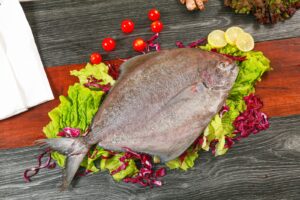Halibut is cherished for its sweet, mild taste and meaty texture. But for those unfamiliar with this large flatfish, questions remain about its flavor. Read on to learn what does halibut taste like along with cooking tips and substitutes.
Table of Contents
Overview of Halibut Fish
Halibut is a type of flatfish found in cold northern oceans:
- Halibut live on the ocean floor on their darkly colored top side, eyes on the upward-facing side.
- Pacific and Atlantic halibut are the main edible species. Their thick rectangular bodies can reach up to nine feet long!
- Halibut is the largest of all flatfish with firm, widely spaced flakes of white fish meat.
- Wild-caught halibut is in season during the spring and summer months when stocks are more abundant.
- Halibut lend themselves well to grilling, baking, broiling and sautéing. They are also served raw as sushi and sashimi.
Now that you know more about this unique fish, let’s explore its distinctive flavor.
What Does Halibut Taste Like?
Halibut has a mild, slightly sweet taste and meaty yet flaky texture. The raw flesh ranges from translucent when very fresh to white. When cooked, it turns opaque white and firm.
More specifically, halibut flavor has the following characteristics:
- Sweet, delicate and lean white fish taste
- Clean fresh flavor with no “fishiness”
- Very subtle hints of butter or nuts
- Medium-firm, flaky texture when cooked
- Moist and juicy with a nice flake
The smaller tails and cheeks offer the sweetest flavor. Larger fillets can be slightly tangy while retaining a mild taste. Freshness is key when choosing halibut.
How Halibut Compares to Other Fish
Halibut has some similarities to other white fish but many unique qualities:
Cod
- Taste: More neutral flavor than halibut. Halibut is sweeter.
- Texture: Cod is finer-grained while halibut is more flaky.
- Fat content: Cod is slightly fattier. Halibut is very lean.
Flounder
- Taste: Flounder has a stronger “bottom feeder” taste. Halibut is cleaner.
- Texture: Flounder contains smaller flakes. Halibut is meatier.
- Fat content: Both are low-fat but halibut has a richer mouthfeel.
Tilapia
- Taste: Tilapia has a milder, simpler flavor. Halibut is more nuanced.
- Texture: Tilapia offers smaller, more numerous flakes. Halibut has meatier texture.
- Fat content: Tilapia is nearly as lean as halibut.
Mahi Mahi
- Taste: Mahi mahi has a medium-firm, sweet flavor profile most similar to halibut.
- Texture: Halibut’s flakes are slightly larger. Both are moist, succulent.
- Fat content: Mahi contains slightly more fat with a richer flavor.
How to Cook Halibut
There are many excellent ways to cook halibut to bring out its best qualities:
- Baked – Often topped with herbs, lemon and butter. Bake until it flakes easily, at 140°F.
- Grilled – Works well on a cedar plank or fish grill. Cooks fast so watch carefully.
- Sautéed – Cook halibut steaks in a pan with olive oil over med-high heat 2-3 minutes per side.
- Poached – Gently cook halibut fillets immersed in liquid on the stovetop or in the oven.
- Fried – Batter or breadcrumbs with shallow frying in oil yields a crispy, flavorful crust.
- Seared -Cook in a hot pan before finishing in the oven. Creates a nice browned exterior.
- En papillote – Bake seasoned halibut in parchment paper bags to steam and seal in moisture.
Avoid overcooking, as halibut can dry out easily. Check often as it cooks quickly.
What Foods Go Well with Halibut
Halibut’s mild, slightly sweet taste pairs nicely with:
- Lemon, lime, white wine or vinegar – cuts through the richness
- Butter, olive oil, herbs – complement the subtle flavor
- Green veggies – broccoli, asparagus, green beans
- Citrus, pineapple, mango salsa – echo the sweetness
- Starch to soak up juices – rice, potatoes, pasta
- White sauces – beurre blanc, hollandaise, Alfredo
Avoid strong marinades that can overpower delicate halibut. Let the fresh fish flavor shine through.
Where to Buy Fresh Halibut
Check these sources to find fresh halibut year-round:
- High-end grocers and seafood markets, either fresh or frozen
- Fish counters at well-stocked supermarkets
- Local fishmongers, especially in coastal areas
- Directly off the fishing docks if located near harbors
- Online retailers offering overnight shipping on frozen fillets
- Stock up during peak season of March through November
Look for clear eyes, shiny skin, and firm flesh without discoloration. Smell for ocean freshness without ammonia odors.
Nutrition Facts: The Health Benefits of Eating Halibut
Halibut provides important nutrients and health benefits:
- High-quality complete protein – around 22g per 3 ounce serving
- Rich in selenium, niacin, potassium, vitamin B12
- Excellent source of lean protein when trying to lose weight
- Rich in heart-healthy omega-3 fatty acids like EPA and DHA
- Low mercury levels compared to other large fish
- Sustainably fished and environmentally friendly
Halibut is considered one of the healthier fish options that is also delectable. It offers a great way to get vital nutrients.
Key Takeaways on Halibut’s Taste and Texture
In summary, here are the key points to know about halibut:
- Halibut has a sweet, mild white fish taste with a hint of butter and nuts. The texture is firm yet flaky when cooked properly.
- It compares favorably to cod or flounder with its cleaner, sweeter flavor and meaty mouthfeel. Mahi mahi is the closest match.
- Halibut suits a variety of cooking methods including baking, grilling, sautéing and poaching. It pairs well with lemon, herbs and white sauces.
- Choose fresh, sustainably caught halibut when possible. Look for translucent flesh without discoloration.
- Halibut provides high-quality protein along with heart-healthy omega-3s. It is considered one of the healthier fish choices.
With its great taste and nutrition, halibut is a prized fish that is versatile in the kitchen. Understanding its flavor helps you cook it optimally.


